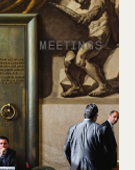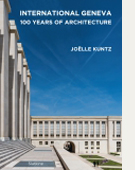International Geneva Documentation
Cantonal legislation
2025
Law granting a monetary subsidy of 25 million francs to the Foundation for the Adaptation of International Geneva in 2025 (L13656)
State of Geneva - 20 June 2025
Arrêté fixant les modalités de soutien aux organisations internationales non gouvernementales (ONG) entamant leurs activités au sein de la Genève internationale
République et canton de Genève - 12 février 2025
2012
Articles 146 et 147 de la Constitution de la République et canton de Genève relatifs à la Genève internationale
Constitution de la République et canton de Genève - 14 octobre 2012
Arrêté précisant les modalités de l'aide fournie par le biais du fonds de la solidarité internationale aux missions des pays les moins avancés (PMA) auprès des institutions internationales établies à Genève.
République et canton de Genève - 10 octobre 2012
2004
Loi sur les relations et le développement de la Genève internationale (LGI) (A 2 65)
République et canton de Genève - 2 décembre 2004
2002
Règlement d'application de la loi sur le financement de la solidarité internationale (RFSI)
République et canton de Genève - 19 juin 2002
2001
Loi sur le financement de la solidarité internationale (LFSI) (D 1 06)
République et canton de Genève - 4 octobre 2001
Federal legislation
2011
Ordinance on Conditions for Entry, Stay and Work for Private Household Employees of Individual Beneficiaries of Privileges, Immunities and Facilities (Private Household Employees Ordinance, PHEO)
Swiss Federal Council - 6 June 2011
2007
Ordinance to the Federal Act on the Privileges, Immunities and Facilities and the Financial Subsidies granted by Switzerland as a Host State (Host State Ordinance, HSO)
Swiss Federal Council - 7 December 2007
Federal Act on the Privileges, Immunities and Facilities and the Financial Subsidies granted by Switzerland as a Host State (Host State Act, HSA)
Swiss Confederation- 22 June 2007
Cantonal reports and statements
2024
Les organisations internationales établies à Genève : résultats de l’enquête 2024
Office cantonal de la statistique - 23 décembre 2024
2023
Les organisations internationales établies à Genève : résultats de l’enquête 2023
Office cantonal de la statistique - 21 décembre 2023
2022
Rapport du Conseil d’Etat au Grand Conseil sur la Genève internationale
Grand Conseil - 21 décembre 2022
Les organisations internationales établies à Genève : résultats de l’enquête 2022
Office cantonal de la statistique - 8 décembre 2022
2021
Les organisations internationales établies à Genève : résultats de l’enquête 2021
Office cantonal de la statistique - 6 décembre 2021
2020
Les organisations internationales établies à Genève : résultats de l’enquête 2020
Office cantonal de la statistique - 29 octobre 2020
Rapport du Conseil d’Etat au Grand Conseil sur la politique de la solidarité internationale pour l'année 2019
Secrétariat du Grand Conseil - 11 mai 2020
2019
Les organisations internationales établies à Genève : résultats de l’enquête 2019
Office cantonal de la statistique - 3 octobre 2019
Rapport du Conseil d’Etat au Grand Conseil sur la politique de la solidarité internationale pour l'année 2018
Secrétariat du Grand Conseil - 8 mai 2019
2017
Résolution 820 pour la poursuite des mesures de soutien à la Genève internationale
Grand Conseil - 24 février 2017
2016
Rapport du Conseil d'Etat au Grand Conseil sur les mesures cantonales de soutien à la Genève internationale
Secrétariat du Grand Conseil - 9 mars 2016
Federal reports and statements
2025
Message concernant les mesures à mettre en œuvre pour renforcer le rôle de la Suisse comme Etat hôte pour la période 2026 à 2029 (French)
Federal Council - 20 June 2025
The Federal Council is investing a quarter of a billion Swiss francs to strengthen International Geneva
Federal Council - 20 June 2025
2020
Stratégie de politique extérieure numérique 2021-2024
Conseil fédéral - 4 novembre 2020
2019
Message concernant les mesures à mettre en œuvre pour renforcer le rôle de la Suisse comme Etat hôte pour la période 2020 à 2023
Conseil fédéral - 20 février 2019
Depuis 2014
Rapports sur la politique extérieure
Conseil fédéral
Joint reports and statements
2019
Déclaration conjointe des autorités hôte de la Genève internationale
Confédération suisse, République et canton de Genève, Ville de Genève - 16 septembre 2019
2013
La Genève internationale et son avenir, état des lieux, défis et stratégies
Confédération suisse, République et canton de Genève - 27 juin 2013
2012
Entente entre la Confédération suisse et la République et canton de Genève concernant le Groupe permanent conjoint sur les priorités de la Genève internationale
Confédération suisse, République et canton de Genève - 16 mars 2012
Other reports
2025
Special Report: Paying for Multilateralism Amid Global Shocks: Financing of International Organizations in Geneva, 2013-2023
Geneva Graduate Institute - June 2025
2024
Paying for Multilateralism: Taking Stock on the Financing of International Organisations in Geneva, 2000-2020
Geneva Graduate Institute - June 2024
Etude sur l'impact du secteur international à Genève
Fondation pour Genève - 5 March 2024
2023
Etat des lieux de la Genève internationale 2023, Bulletin N°5: Science Diplomacy: an opportunity for Geneva
Fondation pour Genève - June 2023
2022
Etat des lieux de la Genève internationale 2022, Bulletin N°4: International Geneva and the Climat Emergency
Fondation pour Genève - May 2022
2021
Impact of Covid-19 on international NGOs in Geneva: 2020-21
International Geneva Welcome Centre - April 2021
La Genève internationale, Étude pôle santé, Bulletin N°3: COVID-19, que fait la Genève internationale ?
Fondation pour Genève - Mars 2021
2020
Etat des lieux de la Genève internationale 2020: Bulletin N°2 - Internet Governance in International Geneva
Fondation pour Genève - September 2020
2019
Etat des lieux de la Genève internationale 2019: Bulletin N°1 - Étude pôle santé
Fondation pour Genève - Décembre 2019
Cartographie des ONG au sein de la Genève internationale
Université de Genève - Août 2019
2015
Impacts de la Genève internationale sur l’économie et les finances suisses et du Grand Genève
Université de Genève - Janvier 2015
This brochure is intended for members of the international community who are based in Switzerland as well as anyone interested in Switzerland's activities as a host state. By combining a brief history with interesting facts, it reveals how Switzerland's ambitious and visionary host-state policy enabled it to become the foremost centre of global governance and international cooperation.
 For more than a year the photographer Christian Lutz has been observing Geneva's 'ballet' of international cooperation. Through his eyes, we catch a rare glimpse of the rich diversity of people, meetings and relationships and the myriad of ways they collaborate. Under-secretaries, interns, ambassadors, meteorologists, nutritionists, physicists... Lutz has observed them all.
For more than a year the photographer Christian Lutz has been observing Geneva's 'ballet' of international cooperation. Through his eyes, we catch a rare glimpse of the rich diversity of people, meetings and relationships and the myriad of ways they collaborate. Under-secretaries, interns, ambassadors, meteorologists, nutritionists, physicists... Lutz has observed them all.
 How did Geneva acquire its international renown? Who put this small Swiss city on the world map? When and why did this happen? Was it planned, or did it happen by chance? With this book, Joëlle Kuntz takes a concise and irreverent look at a story that is familiar yet seldom told: the emergence of Geneva as an international city.
How did Geneva acquire its international renown? Who put this small Swiss city on the world map? When and why did this happen? Was it planned, or did it happen by chance? With this book, Joëlle Kuntz takes a concise and irreverent look at a story that is familiar yet seldom told: the emergence of Geneva as an international city.
 This book retraces the various stages leading to the construction of the buildings that make up the city's international quarter today. The turbulent history of office architecture writ large is embedded in the canton's small territory, featuring, from the start, a quarrel about modernity, instigated by Le Corbusier over the Palais des Nations. From the austere stone building inaugurated in 1926 for the International Labour Organisation to the glass bubbles occupied by the Maison de la Paix since 2014, this architectural journey is recounted for the firt time here.
This book retraces the various stages leading to the construction of the buildings that make up the city's international quarter today. The turbulent history of office architecture writ large is embedded in the canton's small territory, featuring, from the start, a quarrel about modernity, instigated by Le Corbusier over the Palais des Nations. From the austere stone building inaugurated in 1926 for the International Labour Organisation to the glass bubbles occupied by the Maison de la Paix since 2014, this architectural journey is recounted for the firt time here.